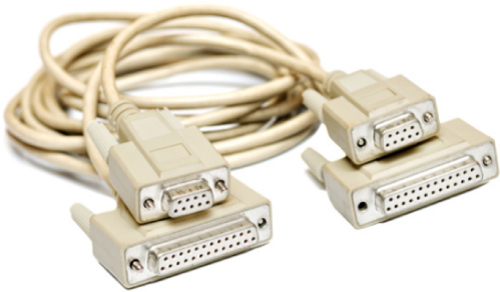What Are RS-232, RS-422 and RS-485?
EIA-232, EIA-422 and EIA-485 are different standards for serial data communication between telecommunications and industrial equipment. The standards are maintained by the Electronics Industry Alliance and are based on older versions of the standards that were developed in the 1960s. These standards were originally called RS-232, RS-422 and RS-485, and the terms are used interchangeably today.
These “recommended standards” (RS) define the electrical characteristics of signals sent between devices as well as the physical size and layout of the plugs and ports used as connectors.

This document provides a high-level overview of both DCE and DTE device types. Digi devices come in both of these types. The cabling you need will depend upon the type of device you want to connect to with your Digi device.
You can find additional resources at the end of this article.
Connecting DTE to DCE
Serial communications connect Data Terminal Equipment (DTE) to Data Communications Equipment (DCE):
- Devices with DTE interfaces are most commonly found at the end of a data chain, such as terminals, printers, computers, controllers, PLCs, motors, etc. DTE devices create, monitor, manage, control or display information.
- Devices with DCE interfaces include modems, radios, CSU/ DSU units and similar equipment designed to provide a connection pathway for information (for example, to a phone line, WAN network or over-the-air).

Internet of Things (IoT) Example
The display in a digital signage application is the DTE, while
the cellular router that links the sign to the Internet has a DCE
interface in this instance.

Cable Use Case Examples
RS-232, RS-422 and RS-485 can all be used in various IoT applications and all three are supported by a number of different Digi routers. Both RS-232 and RS485 can be used in several physical formats, including with DB9 and RJ45 serial ports.
RS-232
RS-232 is typically used for inexpensive, relatively slower communications over short distances. It was originally introduced by the EIA in 1960 and is the oldest common standard for serial communication. RS-232 is still in very wide use today.
The RS-232 standard includes one transmit wire, one receive wire and a single reference ground for transmit, receive and all hardware control signals. Other characteristics include:
- Maximum distance (cable length) of approximately 15 meters (50 feet).
- Data speeds of up to 115 Kbps for short distances, but speed decreases with distance. (Some special chips can support faster speeds.)
- Used in point-to-point communications only.
Enterprises often select RS-232 when simplicity rather than distance is their primary concern. Because RS-232 is so common, it is compatible with a wide variety of systems and devices. Out-of-band management for IT equipment is a major use case for serial deployment. Other systems such as building security, alarms, cash drawers, and many more can use this protocol.
RS-422
RS-422 is an updated version of the original RS-232 protocol. This newer standard addresses some limitations of RS-232, using balanced signals (Transmit + and Transmit -, Receive + and Receive -) to allow reliable data transmission at higher speeds over longer distances than is possible with RS-232. Other characteristics include:
- Maximum distance of approximately 1,200 meters (4,000 feet)
- Data transmission speeds up to 10 Mbps
- Recommended for point-to-point communications, with limited multi-drop capability
RS-485
RS-485 is an extension of the RS-422 standard and allows true multipoint communications between devices on a single wire. RS-485 allows up to 32 drivers and receivers to be on a single two-wire bus. With serial repeaters or special drivers, this number can be expanded to hundreds or thousands of nodes.
RS-485-compatible chipsets have the ability to turn their (tri-stated) transmitters on and off very quickly, so that multiple transmitters can be attached to the network and activate as necessary. Because long idle times are not required, the network can be used at very high utilization rates. Other characteristics of RS-485 include:
- Maximum distance of approximately 1,200 meters (4,000 feet)
- Data transmission speeds up to 10 Mbps
- Recommended for use in multipoint communications
Distance is the major reason to choose RS-485. RS-485 is also the multipoint communications standard required by the Modbus application protocol, which is used in programmable logic controllers (PLCs) that appear in a large variety of industrial applications. The Modbus protocol allows a chain of addressable devices to report data through a single serial connection.
See the Digi Cable Guide and the documentation for your specific product at lte.callmc.com/digi.
USAT CAN HELP YOU DECIDE
In mission critical industrial automation applications, every link in the data chain must be reliable, and cable can sometimes be the weak link. Using the incorrect cable can result in lost or corrupted data, damaged equipment, inadequate monitoring, and even operator injury. Take time to make sure you choose the cable best suited to your specific industrial application, and that the configuration of your entire industrial deployment is robust, secure and designed to meet your specific application needs. The Digi experts at USAT can help. Contact us to start the discussion.
Contact USAT
Our Digi Solution Engineers are ready to assist you with your upcoming connectivity products. If you need help procuring Digi Endpoints and Software please reach out to the team at USAT using one of the three contact methods detailed below.
For More Information:
- Give Us a Call: (919) 942-4214
- Send Us an Email: info@usatcorp.com
- Request a Consultant: Click Here
Share this Post













